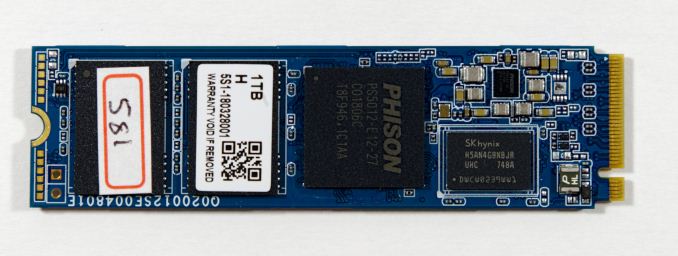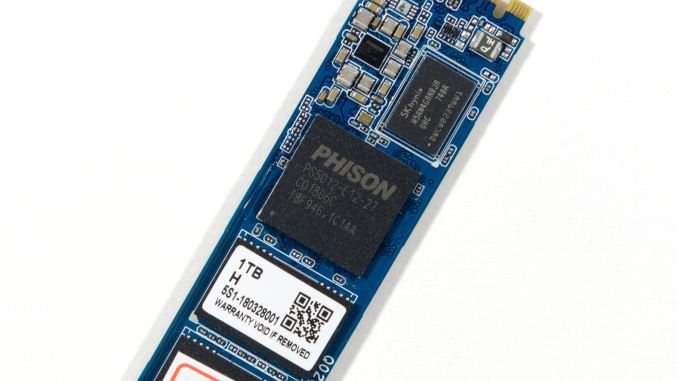The Phison E12 Reference Design Preview: A Next-Gen NVMe SSD Controller
by Billy Tallis on July 18, 2018 10:30 AM ESTLooking Forward
For months now, it has been clear that the best TLC-based SSDs are fast enough that even more expensive drives using MLC NAND or 3D XPoint memory are almost never justified. The Phison E12 controller does very little to further raise the bar for TLC SSDs, but it brings another player back in to competition at the high end. Within a few months, almost every SSD brand should be offering a respectably competitive high-end NVMe SSD. Most importantly for consumers, this will include brands such as MyDigitalSSD that are known for aggressively low pricing but have so far been limited to SATA and low-end NVMe drives when using Phison reference designs.
The Phison E12's best test results came from the write tests, where it set new records for burst sequential and random writes. Other drives with Toshiba/SanDisk 3D TLC tend to do well on write performance or power efficiency, so the Phison E12 isn't the top drive in all write-heavy tests. The E12's performance drops significantly when the SLC cache gets filled up and if the drive doesn't have enough time to finish flushing the cache before the next test phase, but even those performance drops only bring it down to about twice as fast as any SATA SSD. Phison probably could tune their SLC caching and garbage collection to offer better or more consistent sustained write performance on our synthetic tests, but it doesn't appear that such optimization is necessary for great real-world performance.
On the read side of things, the E12 offers good high-end performance but the HP EX920 with the Silicon Motion SM2262 controller and Micron 64L 3D TLC currently holds on to some impressive performance records. Silicon Motion should be able to expand that lead with their upcoming SM2262EN controller, so Phison either needs to figure out how to get better read performance out of Toshiba's 64L TLC, or hope that their 96L TLC will take care of the problem.
The Phison E12 consistently delivered very low read and write latencies on all of the ATSB tests, even when the Heavy and Light tests were run on a full drive. This applies not just to average latency but also 99th percentile latencies; the Phison E12's performance on these real-world storage workloads is consistently good.
The power efficiency of the Phison E12 is generally pretty good, even when the performance is not competitive with the top drives. The Phison E12 isn't quite as low-power as the year-old Toshiba XG5 that was the first shipping drive with this BiCS3 3D TLC NAND, but most of the tests where the E12 is more power-hungry are tests where the E12 is delivering enough extra performance to justify the power consumption. However, on almost all tests, the most efficient NVMe SSD is the impressive WD Black, which combines the same 3D TLC with Western Digital's in-house controller to deliver top performance with efficiency comparable to SATA SSDs.
Overall, the performance of the Phison E12 is competitive for today's SSD market given the price range I expect retail versions to show up in. Phison hasn't managed to leapfrog the competition in any big way, but they've caught up with the high-end for the first time since NVMe came to the consumer SSD market.
Phison may be able to continue incrementally improving performance through firmware updates, but it doesn't appear that the combination of the E12 controller and 64L TLC is at all future-proof when it comes to competing against the other drives that will be hitting the market during the second half of this year. Drives based on the Phison E12 will probably end up with more of a mid-range status within the NVMe SSD market, unable to deliver top performance but coming fairly close for a much smaller price. That should make E12 drives a pretty successful family of products with more mainstream appeal and affordability than Samsung's premium NVMe drives.
Looking back at how the Phison E7 fared as their first NVMe controller, the E12 is a huge improvement. The E7 was touted by many brands as a component for high-end SSDs, but it never really delivered. The most successful E7 products were the cheapest ones that didn't try to compete head-on with Samsung. The E7 controller also initially hit the market with relatively immature firmware, so many later products had substantially better (or at least different) performance from the first wave of releases. Phison has no obvious firmware flaws with the E12 platform, and it's probably ready to hit the stores.












28 Comments
View All Comments
gglaw - Thursday, July 19, 2018 - link
new cheap competition is exactly what the market needs. I've posted this before but the pursuit of performance for most of the readers here is pretty much wasted unless i've gotten so insensitive to speed changes I can't tell the difference anymore. I have more computers that I'm embarassed to admit to and more parts than I have time to finish building more to test. SSD's in general I wouldn't be surprised if I've tested more than the whole AT staff literally, and not just running a few hours of the same suites, hundreds of hours through my LAN room. I've had every major SSD chipset released for at least several years and within I'd say the last 2-3 years I can tell absolutely no difference between the cheapest 3D NAND SATA drive and the 970 EVO and ADATA 8200 which is a gem most people haven't even heard of that are among the fastest drives ever produced for consumer use. My slowest drives are the Micron 2TB dirt cheap $250 drives that go on sale every 2 weeks (cheapest per GB drive ever made), a couple Crucial MX 3D NAND drives, a few enterprise Samsung/HP pulls that are actually brand new sold through Newegg outlet, and some Samsung 850 non-pro's. Especially on the Destroyer tests the numbers look dramatically different, but this test is absolutely useless for at least 99% of the users on this site other than the few big organization admins who frequent these comments routinely.No one including myself through hundreds of hours through my LAN room have noticed/commented on any speed difference running Twitch/streaming, chat engines, browsers, while doing many hours of OW, WOW, HOTS, and Steam library games. This is about the intensity of use of the vast, vast majority of the public, likely moreso. Now other than my one flagship with about the fastest you can get of every piece, all I go for is cheap $/GB and decent warranty on my SSD's. My current flagship is the top Ryzen2, ADATA 8200 NVME drive (basically same as 970 EVO which is in my Coffee Lake rig), GTX 1080 - and sadly the only noticeable difference is playability on higher graphics settings due to the GTX 1080s on the higher machines. The 16 threaded CPU and turbo SSD's no one can tell is even in the box. And the budget machines running RX 580s, GTX 1070s/1060s, do everything identical to the flagships other than a couple graphics settings needing to be turned down. (All the rigs are also only going at 1440p since I never felt it was enough of a difference to justify the cost to go 4k).
romrunning - Thursday, July 19, 2018 - link
The only point I think you've established is that you haven't run any loads that significantly use any one component - SSD, CPU, or GPU. Well, at least you saw the GPU difference in "higher settings". If you're just doing games, I can see why you might think the big performance products don't have much of an impact. However, depending on your use case, there can be huge performance/time savings in different products.A high-thread count CPU can make significant time differences in rendering. So if that is something you do a lot, especially if you do this for work, then you will notice a huge difference in the time saved on rendering.
In virtual server hosts, you can tell a difference from an all-SSD array vs all-HDD array in the responsive of the virtual guests. In databases, you can tell big differences in SSD storage vs HDD storage (not considering memory), especially with disk I/O-intensive backups & restores.
So these are just some use cases that can highlight the significant impact of better-performing components. But all cases are different in their usage scenarios. We can't just give up on seeking better performance & go only for low-cost just because our particular use-case doesn't really display the impact of higher-performing parts.
PeachNCream - Thursday, July 19, 2018 - link
I think the point of the post you were responding to was to argue that there is little real world difference in most home computing scenarios between different SSDs (not SSDs vs HDDs as your response points out) despite the benchmarks showing sometimes dramatic performance advantages or disadvantages. The other accompanying parts of the post that wander into the CPU and GPU were just there to enhance the credibility of the claim by offering an argument of broad experience.romrunning - Thursday, July 19, 2018 - link
I, too, wish for more performance MLC products; however, I think we might just transition to Optane drives & hope they go down faster in price.The_Assimilator - Thursday, July 19, 2018 - link
Article title: "A Next-Gen NVMe SSD Controller"Article conclusion: "...it doesn't appear that the combination of the E12 controller and 64L TLC is at all future-proof."
shabby - Thursday, July 19, 2018 - link
Need a catchy title for them clicks.Holliday75 - Thursday, July 19, 2018 - link
It is Phison's next gen controller.tygrus - Thursday, July 19, 2018 - link
28nm for the controller isn't new. I assume they could decrease power consumption if they used smaller fab node like 22nm. The FLASH chips themselves use/produce a lot of heat as well and 28nm might be cheaper than 22nm so compromises were made. Maybe they could bring out another version for higher performance AIC PCIe x8 or PCIe v4 signals next year (22nm fabed controller).